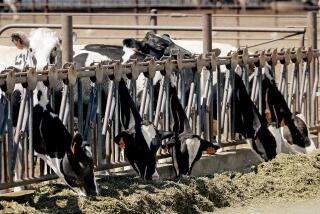1 Million Hens Ordered Destroyed as Poultry Quarantine Is Expanded
State officials ordered more than 1 million egg-producing hens destroyed and expanded a poultry quarantine Monday after finding new cases of a fast-spreading and deadly avian virus in San Bernardino and San Diego counties.
The developments heightened concerns that exotic Newcastle disease, which recently surfaced at a Riverside County egg farm, was proliferating and could pose a threat to California’s $3-billion poultry industry.
Egg and poultry farms in Riverside County -- the state’s No. 1 egg producer -- have been under quarantine for the last several weeks, along with ranches in Los Angeles and San Bernardino counties. More than 100,000 commercial chickens already have been destroyed by agriculture officials.
On Monday, the quarantine was extended to San Diego County after laboratory tests confirmed infection at a farm with 75,000 hens. All of those birds will be destroyed, as will 1 million hens at a San Bernardino egg ranch also found to have cases of the disease.
Orange County, which has no poultry production, was added to the quarantine list as well to stop the movement of birds across the region.
“All of the commercial egg facilities are on heightened alert,” said Leticia Rico, a spokeswoman for the California Department of Food and Agriculture. “We are working closely with their vets to enhance biosecurity practices” to contain the disease.
Egg operations throughout the Southern California quarantine area can still sell their products -- the disease does not pose a threat to humans -- but poultry farmers cannot. The Southland is home to a fraction of the 280 million chickens and turkeys raised in the state.
No sign has emerged that the disease has spread to any poultry processors in the Central Valley, where nearly all of the state’s meat birds are found.
There is no vaccine or treatment for the deadly virus, which causes flu-like symptoms in fowl.
State officials said they still are investigating the source of the outbreak. They declined to say whether the Southern California egg farms used a common processing facility, which could have contributed to the spread of the disease.
“We were hopeful that we could keep it isolated to the flocks it started with,” said Bill Mattos, president of the California Poultry Federation.
But unless the Southern California egg producers did in fact share a common processing facility, he added, the disease could be on the move.
The industry and state agriculture officials are working to develop more rigorous measures to curb the disease. State officials intend to test more farms around the infected facilities, in addition to collecting samples of dead hens across California.
Poultry farmers who are found to have an infected flock must destroy their birds, but they will receive compensation from the state.
The farmers are not, however, compensated for the weeks or months of lost egg production, industry observers complain.
Exotic Newcastle disease was first spotted in September in a flock of backyard chickens in Compton. It was the first time the disease had surfaced since the early 1970s, when 12 million chickens had to be destroyed at a cost of more than $50 million. The disease took almost three years to eradicate.
More to Read
Sign up for Essential California
The most important California stories and recommendations in your inbox every morning.
You may occasionally receive promotional content from the Los Angeles Times.










